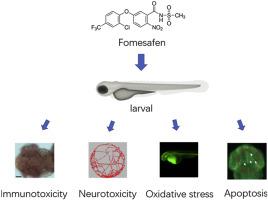Chemosphere ( IF 8.1 ) Pub Date : 2020-06-12 , DOI: 10.1016/j.chemosphere.2020.127380 Zhaopeng Xu 1 , Huiwen Ni 2 , Yong Huang 3 , Yunlong Meng 3 , Zigang Cao 2 , Xinjun Liao 2 , Shouhua Zhang 4 , Xinchun Guo 1 , Huiqiang Lu 5

|
Fomesafen is widely used in agriculture and can be detected in the environment and agricultural products. Research on the developmental toxicity of fomesafen in animals is currently very limited. Here, we used zebrafish as an animal model to evaluate the toxicity of fomesafen in developing aquatic vertebrates and higher animals. From 6h to 72h following fertilization, exposure of zebrafish embryos to 5, 10 and 20 mg/L of fomesafen resulted in pericardial edema, a reduction in heart rate, shortening of body length, and yolk sac edema. Fomesafen reduced the number of immune cells such as neutrophils and macrophages, increased the expression of a number of inflammatory factors, induced the up-regulation of the oxidative stress response and apoptosis, and disrupted the activity of enzymes related to nerve development, which affected the motility of the embryos. In conclusion, the results provide new evidence for the comprehensive assessment of fomesafen toxicity in aquatic vertebrates.
中文翻译:

Fomesafen对斑马鱼胚胎发育的影响。
Fomesafen广泛用于农业,可以在环境和农产品中检测到。目前在动物中对福莫沙坦的发育毒性的研究非常有限。在这里,我们使用斑马鱼作为动物模型来评估fomesafen对发育中的水生脊椎动物和高等动物的毒性。受精后6h至72h,将斑马鱼胚胎暴露于5、10和20 mg / L的fomesafen中会导致心包水肿,心率降低,体长缩短和卵黄囊水肿。Fomesafen减少了中性粒细胞和巨噬细胞等免疫细胞的数量,增加了多种炎症因子的表达,诱导了氧化应激反应和细胞凋亡的上调,并破坏了与神经发育相关的酶的活性,这影响了胚胎的活力。总之,结果为水生脊椎动物fomesafen毒性的综合评估提供了新的证据。































 京公网安备 11010802027423号
京公网安备 11010802027423号